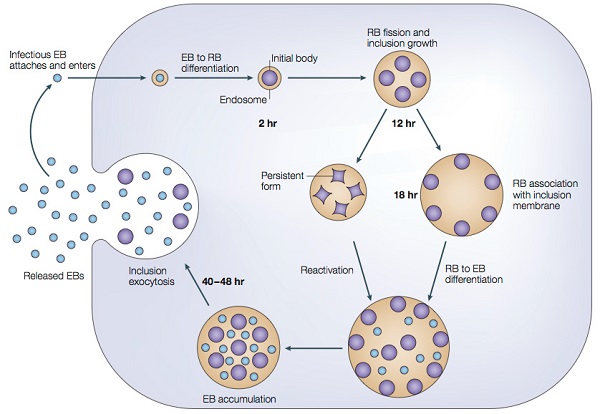Chlamydia trachomatis - Pathogenesis, Pathology, Host immunity, Transmission
Transmisssion of Chlamydia trachomatis
Chlamydia trachomatis is a common cause of STI and a major cause of PID, ectopic pregnancy, and infertility. It causes disease mainly by:
direct destruction of infected host cells during multiplication
inducing inflammatory responses in the host
Pathogenesis, Pathology of Chlamydia trachomatis
Chlamydia trachomatis enters the host through minute abrasions/injuries on the skin. It reacts specifically with receptors present in epithelial cells of mucosa, blood vessels, smooth muscle cells, non-ciliated columnar, and cuboidal cells.
These epithelial cells of Chlamydia trachomatis are also found on mucous membranes of the conjunctiva and genitourinary system (urethra, endocervix, endometrium, fallopian tube) and respiratory tract.
Chlamydial EB is phagocytosed into a host cell and prevents phagolysosome fusion, leading to intracellular persistence of Mos and escape from the host immune response. It can turn on/off apoptosis (programmed cell death) in an infected host cell.
By inducing apoptosis, micro-organism facilitates their transmission to neighboring cells and down-regulate inflammation in the acute disease process. By inhibiting apoptosis, the Chlamydia trachomatis keeps the host cells alive, allowing for sustained survival in chronic infections.
In Lymphogranuloma venereum (LGV), pathological lesions called granuloma are found in lymph nodes that drain the site of primary infection. It multiplies in mononuclear phagocytes found in the lymphatic system. Subsequently, the inflammatory process spreads to surrounding tissues. Finally, lymph node ruptures and abscesses on sinus tracts are formed.
Infections with trachoma serovars are associated with severe inflammatory reactions consisting of neutrophils, lymphocytes, and plasma cells.

Fig: Chlamydia trachomatis multiplication in host cell (Source: MDPI)
Host immunity against Chlamydia trachomatis
Infected epithelial cells secrete pro-inflammatory cytokines to provide host immunity against Chlamydia trachomatis including
Interleukin – 1α (TL- 1α)
Tumor necrosis factor (TNF)
IL-6
Neutrophils and monocytes migrate to the mucosa and eliminate exposed EB quickly upon infections. Later, CD4 T-helper cells migrate to the site of infections. Responding neutrophils and TH cells release cytokines resulting in the influx of additional immune cells.
Immunity provides little protection from reinfection and is short-lived. Reinfection produces a strong inflammatory response with severe tissue damage. It may cause loss of vision in chronic ocular infection; sterility and sexual dysfunction in patients with genital infections.